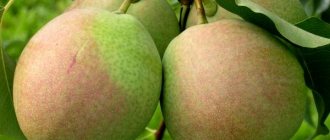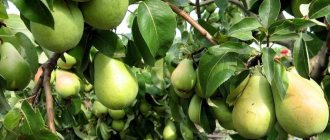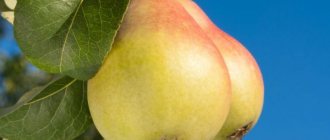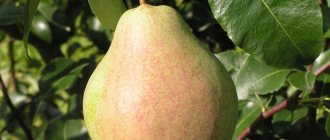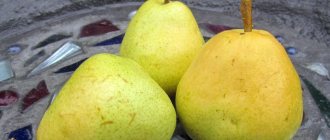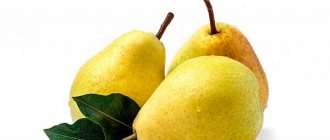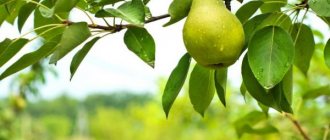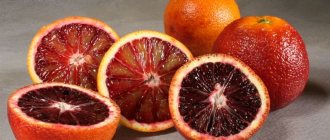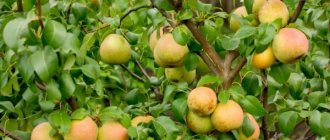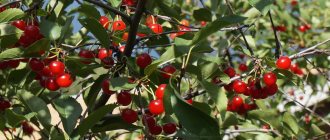What type of pear is it?
Moskvichka pear is a dessert variety with an autumn fruit ripening period . Due to its early fruiting, excellent presentation, good keeping quality and other qualities, it is very popular among gardeners.
The purpose of the Moskvichka fruits is universal. They are very tasty fresh and good for making compotes, preserves, jams, marmalade, candied fruits and dried fruits .
Dessert Rossoshanskaya, Krasulya, Hera, Vernaya and Forest Beauty are also distinguished by their versatility.
History of selection and region of breeding
“Moskvichka” is the result of selection work of the Moscow Timiryazev Agricultural Academy. It was isolated from pear seedlings obtained by open pollination of an American variety called "Kieffer" .
The authors of “Moskvichka” are breeders S. P. Potapov and S. T. Chizhov . The variety began to be grown in the 80s of the last century. It is recommended for cultivation in the Volga-Vyatka, Middle Volga and Central regions of Russia . “Moskvichka” has become widespread in the gardens of the Moscow region.
Reviews
Kristina, 45 years old, Ryazan region : It’s not for nothing that this variety of pear has been praised to me - it has been growing on my plot for 6 seasons, two of which are actively bearing fruit. I use ripe fruits to make jam and cover compotes - they turn out sweet and aromatic. And we put part of the harvest into storage - pears are stored in the cellar for at least 3.5 months.
Olga, 34 years old, Bologoe : you are absolutely delighted with this variety of pear. Abundant, stable fruiting, grows well, without requiring complex care. But during the growth and fruiting of this pear, I never use fertilizers containing nitrogen.
Maria, 50 years old, Penza region : this variety has been bearing fruit in my garden for the third season. The fruits grew even, approximately the same size and weight, sweet and juicy. The Muscovite pear was practically not damaged by frost, I recommend it to other gardeners for cultivation.
Moskvichka pear: variety description and photo
Pear trees of the “Moskvichka” variety have medium-sized dimensions and a standard shape with a dense crown and medium foliage .
Young Moskvich trees have a funnel-shaped crown , which becomes conical as they mature.
The trunk of the tree is gray , and the bark of the skeletal branches growing in an oblique-vertical direction is light gray.
The Moskvichka variety has a good ability to form shoots . They are distinguished by their curved shape, medium length and diameter . Small convex lenticels are present in sufficient quantities on the shoots. The internodes on the branches have a standard length, the cone-shaped buds are colored brown.
The pear leaves are small in size and have an oval shape with jagged edges. The leaf blade is leathery, without pubescence and slightly curved in the center. Pear flowers cup-shaped with a white corolla . From 5 to 7 flowers are collected in racemes. The fruits of the tree are formed on spears, fruit twigs, ringlets of different ages and annual shoots from lateral and apical buds.
The average weight of one Moskvich pear is from 120 to 130 g . Some specimens can reach 200 g or even a little more. The shape of the fruit is broadly pear-shaped . Subcutaneous dots are visible under the yellowish-green skin. Often the skin is covered with pronounced rustiness in the form of large spots . There is no integumentary blush.
The white pulp of the fruit is juicy with a dense semi-oily structure and granulations around the heart. “Moskvichka” has a very pleasant sour-sweet taste with a pronounced fragrant aroma . The tasting score of the Moskvichka pear is 4.3 points , the sugar content of the fruit is 9.5% , and the acidity is 0.48% .
Photo of the pear variety “Moskvichka”:
Characteristics
The variety is remarkable for its stable and high yields even under unfavorable conditions. One tree can produce up to 50 kg of juicy and aromatic fruit . The Moskvichka pear begins to bear fruit in the 4th , sometimes 3rd, year after planting . The harvest ripens by mid-September or a little earlier. It is worth saying that the fruits almost do not fall off when ripe.
The ripeness of the fruit can be determined by the appearance of a slight yellowing on the skin . For longer storage, it is recommended to remove the fruits before the sign of ripeness appears , when the skin is still light green.
Under indoor conditions, the fruits ripen within a week, becoming very juicy and tasty , after which they can be stored for about ten more days. In the basement, pears are stored without compromising their consumer qualities for 3 to 4 weeks, and in the refrigerator at zero temperature for up to 3 months.
The variety has very good endurance , is not afraid of temperature changes and produces stable yields in any weather . However, the winter hardiness of Moskvichka is slightly above average , so in the middle latitudes of Russia it requires winter insulation.
The self-sterile variety “Moskvichka” needs pollination . The best pollinating varieties for this pear: Lada, Naryadnaya Efimova, Bergamot Moscow, Marble, Lyubimitsa Yakovleva.
Diseases and pests
With proper agricultural technology, there are no problems with growing pears. The tree is quite stable and is not afraid of any impacts. Moskvichka pear is protected by immunity from many diseases and practically does not suffer from fungal diseases.
Dangerous Pear Pests
Pears often suffer from pests, they affect the leaves, bark and fruits.
In this article, we have selected 11 of the most harmful insects that harm pear trees, and also ways to destroy them.
Diseases of pear trees
To get what they cherish, gardeners have to work hard, and the reason for this is pear diseases.
Read about 19 common pear diseases and how to combat them.
Planting and care
Pears should be planted in the fall at the beginning of October or in the spring at the end of April-beginning of May . When planting “Moskvichka”, you should make sure that pollinating varieties grow nearby .
The pear requires a well-lit, level and dry place. The more sun the tree's fruits receive, the tastier and sweeter they become .
The plant does not like stagnant moisture in the soil . Groundwater on the site must lie at a depth of at least 2.5 meters from the ground , otherwise the pear will not be able to develop and will die.
Pear trees prefer to grow on sandy-chernozem or loamy soils with an acidity pH of 5.6 to 6.0 . Sandy soil is also suitable , but in this case more careful care will be required , as well as active and regular fertilization. Clay soils are undesirable for pears . To plant in such soil, you will need a large planting hole with suitable soil.
The planting hole must be prepared in advance, at least a couple of weeks before the intended planting. For planting seedlings in the spring, it is best to prepare the hole in the fall. Its optimal dimensions are from 1 to 1.2 m in depth and about 80 cm in diameter .
When digging a hole, the top turf layer (about 30 cm ) is folded in one direction , and the rest of the soil in the other . Next, the hole is filled with fertile soil.
To prepare it, the removed high turf soil must be mixed with 3 buckets of manure or plant humus, a couple of buckets of sand, a glass of superphosphate, 3 tablespoons of potassium sulfate and 1 kg of any organic matter . Next, fill the hole with improved soil and then pour in a solution of dolomite flour (400 g per 10 liters of water). Finally, pour out a couple of buckets of water and leave the pit in this form for 10-14 days or until spring.
Features and growing conditions
The Moskvichka pear variety should be planted in open, well-lit areas. It does not make any special demands on soils, but it develops and bears fruit best on fertile soils with a slightly acidic or neutral reaction.
The place for planting pear seedlings must have good drainage. Stagnant moisture is very destructive for pear trees.
When laying a planting hole, be sure to add 3-4 buckets of well-rotted manure, 1-1.5 superphosphate, about 600 g of calcium chloride and 2.5-3 kg of lime. In the first year after planting, in the absence of rain, the seedlings must be watered. One tree requires approximately 2-3 buckets of water.
Caring for the Moskvich pear in subsequent years of cultivation consists of applying organic fertilizers in spring and autumn once every 2 years. For these purposes, you can use humus or peat at the rate of half a bucket per square meter. When applied in autumn, fertilizers of the phosphorus-potassium group are used.
Among the peculiarities of growing Moskvichka, it is also worth noting its self-sterility. Therefore, pollinators must be planted next to it. The pollinator varieties for Moskvichka pear are as follows:
Useful video
How to properly prepare a planting hole is shown in the video below:
Important - Before planting, most of the leaves on the seedling are torn off , leaving only a few leaves on each branch. The leaves evaporate a lot of moisture , and the roots of the young tree are still very weak .
Planting pear seedlings is carried out as follows:
- Most often, two-year-old pears are planted . When buying a tree, it is recommended to immediately trim the branches , but under no circumstances should you cut the roots. A day before planting, the roots of the seedling are soaked in water or mullein solution ;
- First, a peg is driven into the central part of the hole so that it rises about 50 cm . Next, pour a mound of earth into the hole and place the seedling on it, spreading the roots evenly. It is better to carry out all work with an assistant who will support the tree;
- The hole with the seedling is filled with the remaining soil without fertilizers . At the same time, the young pear is shaken slightly so that the earth can fill the voids between the roots. When planting, the root collar should be located 5 or 7 cm above the ground level ;
- After planting the tree, carefully compact the soil with your feet, spill it with 3 buckets of water, and then mulch the tree trunk with dry humus . Planting work is completed by tying the seedling to a peg.
“Moskvichka” is not very demanding in terms of care. An important condition for proper development is regular loosening of the soil around the tree .
The first loosening to a depth of about 15 cm is carried out immediately after planting . The tree trunk circle should always be kept clean and mulched with peat, humus or manure. Weeds and various debris should be removed in a timely manner .
to water the pear once a week at the rate of 10 liters of water per tree in the morning and the same amount in the evening. Sufficient watering is especially important for pears from July to August , when it bears fruit and when the buds of the future harvest are laid on the trees. The watering regime is adjusted depending on weather conditions . From September, watering stops .
You can start feeding pears the next year after planting. Every spring, the tree is fertilized with ammonium nitrate at the rate of 20 g per 1 sq. m of tree trunk circle.
Every three years, organic fertilizers should be applied in the fall - 50 g of superphosphate, half a bucket of compost or humus and 20 g of potassium sulfate .
Important - In the first season after planting, it is recommended to remove all inflorescences from the seedling so that the tree can take root better.
During the growing season, the pear needs pruning . This must be done in early spring before the buds begin to bloom. When planting, the branches of young seedlings are cut by a third so that they can quickly establish a crown.
The shoots align as they grow , while the leading position of the central conductor is necessarily maintained. Branches growing inward, crooked and weak shoots, and tops are pruned . If the crown is damaged by freezing, strong tops are left and used to replace fruit-bearing branches.
An important point is that when pruning, no more than a quarter of the total number of branches is removed so as not to expose the tree to great stress. If a branch of an adult tree is completely removed, the cut should be made at the base (on a ring) - it is not advisable to leave stumps .
"Moskvichka" is a fairly frost-resistant variety . However, to protect against too low temperatures in the winter, it is necessary to mulch the tree trunk with horse humus. The stamp should be wrapped in insulating material that allows air to pass through . To combat hares and mice, it is best to cover the lower part of the trunk with a special net or coniferous branches with the tops down.
There are other frost-resistant varieties: Nika, Samara Beauty, Svarog, Severyanka Krasnoshchekaya and Uralochka.

